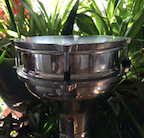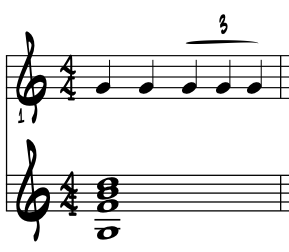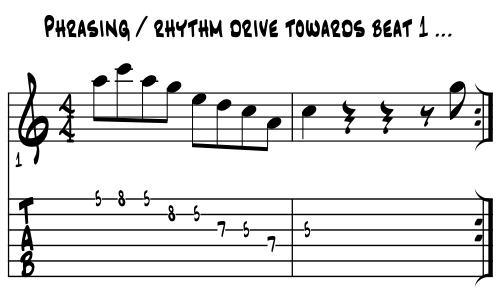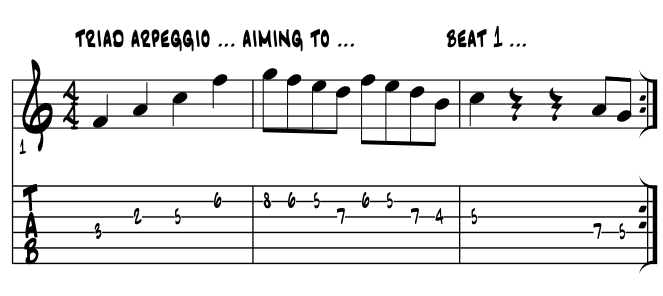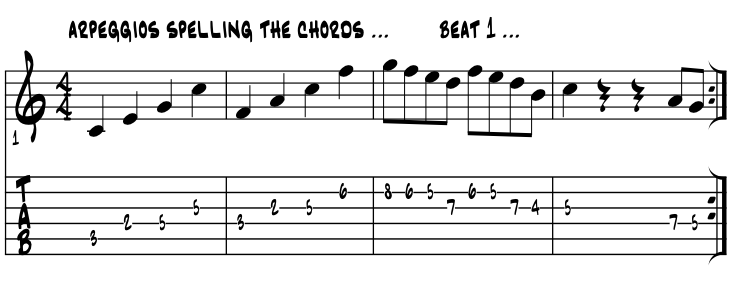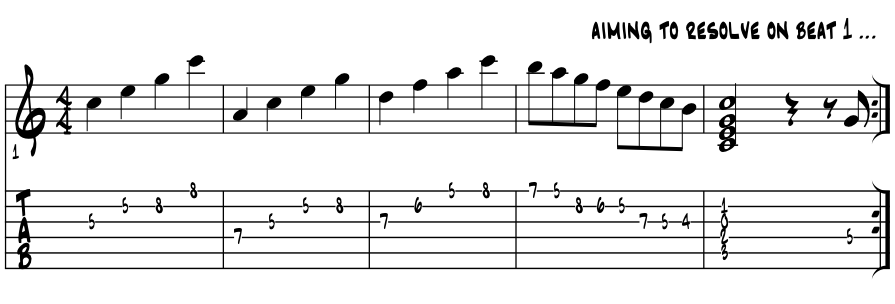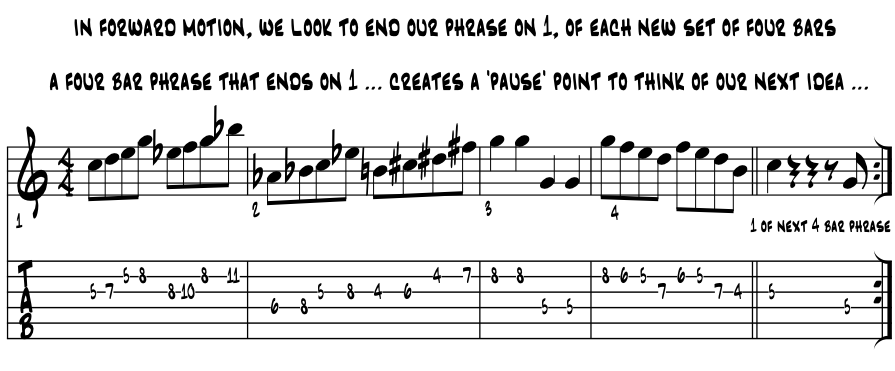"Forward Motion" is the title of a book written by jazz piano wizard Hal Garper. The ideas that follow here, all flow from this graceful work, and creates one of the three capstone level classes of advancement included within our BA level studies here. A warm hearty 'three cheers' thank you to Mr. Garper for putting these challenging concepts into insight prose for the mutual benefit of all. |
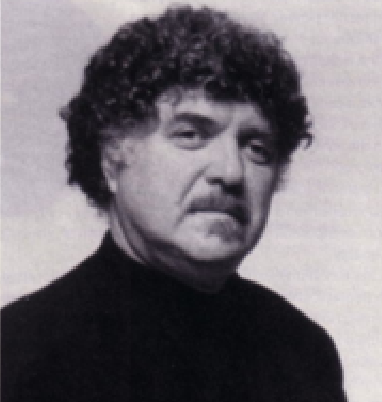 |
Hal Garper |
In a nutshell. The overall idea of 'forward motion' is about phrasing. The 'begin and close points of' our melodic lines. That instead of starting a phrase from a downbeat, we aim our lines to close on future downbeats. We're thinking ahead, so 'forward', and moving through time, so 'in motion.' Whether working solo or with a group, once a 'time' has been established, everyone's phrasing can be 'looking forward' and 'phrasing together' towards the principle downbeats in any song. |
In Forward Motion, Garper describes how Baroque artist J.S. Bach phrases in a similar manner, in music that is written out. And for our Americana musics and studies, how this approach to phrasing can apply to our improvisational thought process. |
Create space in time to think. Thinking 4/4 time and grouping measures into four bar phrases, once the music is up and running and moving along in its groove, we're aiming our musical ideas so that they end on the downbeat, beat one, of the next four bar phrase. Example 1. |
|
So in each of these last three, four bar phrases, we can start our line at any point in the 'space', while aiming for these key points, the first beat of each new phrase in the overall structure. The longer we wait to begin an idea, the longer we get to think :) |
By closing our phrases to these end points, we can pause and take a breath, open up a window of 'space' to think of what our imagination decides to play next. With some practice, this will happen each four bar phrase. And with the hypersonic speed flash lightning quick capabilities of the human mind, our own clarity of thought process and our ability to play what is suggested, evolves. And surely we know that we do this naturally too, with our flashes of inspiration. A new thought that comes so quick in a tight spot to save the day ! Same in music too, we look to strengthen this mental ability while moving through measured time in unmeasured ways. |
This is the basic idea of forward motion. That we are thinking and phrasing 'forward', toward future structural points in the form of the song we are playing. Did you notice the last idea is 12 bars? A perfect Americana song form for thinking on ahead. |
Create space in time to prepare. In practicing, we have the clicks to help focus us 'in time' to a future point in the music, we focus on one beat that's in the near future, where some tricky lick is coming up to start. To practice the riff, get your tempo clicks going and take runs at in the moving time of the clicks. Sort like this, first slowed down to half time then up to speed. Clicks around 108. Example 1a. |
Let the rhythms decide the pitches. Another 'trick' of this forward motion is that if we think or play just the rhythms of a line with one note, as we do so, our muse gets a chance to 'suggest' additional pitches that 'sparks the line' into melodic life. Here's a 12 bar blues in 'G' with a 'One Note Samba' approach, give it a click. Example 2. |
|
Even just one new note. Any ideas shake loose over the four choruses? We cheated a wee bit in bar 12 with the 'blue 3rd' a suggestion of sorts. But if during this exercise, if even one new note was 'muse suggested' as the music moved along in time, then that's the inner connectivity process you're looking for in this concept; brought forth by letting the rhythm suggest the pitches. And just like other exercises, we can strengthen this ability. And since it is pure art / intellectual, there's probably no limit for the creatively searching, inspired artist. |
Advanced ~ floating the changes. Initially there's two levels of floating the changes around. For once we're phrasing to the downbeat of the next four bar phrase, we can first float the changes to different parts of the measures they occur in. Then second, that their order begins to float and we can jazz up the written sequences of chords. In painting, Picasso's move to "cubism" followed this path. For after his 'blue' period, comes cubism. same parts of his picture puzzles floating around to different perspectives for the eye. So we aural weavers of music also get to puzzle up the harmony moving in time. |
|
Learn this magic. Following our additive learning philosophy, so the essence of 'forward motion' is that instead of starting our phrases on a downbeat, we end the line on a downbeat. Here's a one measure lick ending on beat one, thinking in the key of 'C' major. Example 3. |
Two measures. In this next idea, we add a measure, and our melodic line is now 'forward motion for two measures.' Here's a two measure lick ending on beat one of the next measure. Example 3a. |
Three measures. Same additive process, now we've a three measure lick that closes onto beat one of the next measure. Example 3b. |
Four bars. Same process, now with a four measure phrase. Here's a four measure lick, arpeggiating diatonic chords, ending on beat one. And now this beat one is the downbeat of measure one, of the next four bar phrase :) Example 3c. |
Feel the direction, tension and resolution of this phrase? Cool. For there's some tonal gravity employed to create that aural predictability, giving the forward motion a chance to work its magic. |
Into musical forms. At this point we can begin to put our forward motion phrases to work in the song forms we play and hear everyday. The 12 bar blues and its complete three, four bar cycle. The 8 bar song form of "Key To The Highway." Two 8's into 16, and then off to 32 bar forms. This forward motion phrasing bolts right up to all :) |
Forward motion magics. The forward motion magic really starts coming around once we set the measures in motion as music. Then we've a downbeat to aim for of the new phrase just ahead. As we strengthen and project further ahead, to collective focus points of the band, we'll further project our lines, creating marvelous arcs of pitches in signature phrases, telling our stories, which in competent hands, can last a whole 12 bar chorus, aiming the line for the downbeat of the first measure of the next chorus. |
And the upbeats? Usually a good spot to start a phrase, giving our musical lines that sense of being energized towards a future point. Here phrasing four bars to 'the one of our next four bar phrase. Look for the upbeat on the second repeat, to start and forward motion the line anew. Example 4. |
Catch the pentatonic motion in bars one and two? Cool. Hip to "Giant Steps?" For there's a natural sort of learning curve many of us Americana cats evolve through that we find weaving in through Coltrane's solo on this song. It'll pathway for an evolution of the artist well worth exploring. |
"The more upbeats you have in the music, the more it swings." |
wiki ~ Dizzy Gillespie |
Quick review. The basis of creating this 'forward leaning, energy motion ' is to pick a 'future' point in the music and create a phrase that comes to a close at that point. As we evolve in this, we'll bite off bigger and bigger chunks of time. In doing so we give Muse a chance to suggest something to play. Creating some space to think a bit as the time moves along, to allow Muse to suggest to our creative, both are at the heart of learning to improvise in this UYM / EMG curriculum. |
|
Relax, create space to think, all while in motion. Working in this method of forward motion, once our phrase has ended, we can pause. In a sense for as along as we like, knowing we're aiming for the downbeat of the next phrase in the form of the song we are playing. So, a chance to just relax into the motion of time, and take a breath or two. We can grab wee bits of 'quiet time' to allow us to think. A second here, another second or two there etc., is all we need because of how quickly our minds can process what's around us and proceed in safety, or not as the case might be. Muse sometimes wants to take chances yes ? Jazz it up a bit more by momentarily venturing off our 'tried and true', take a leap of sorts and see if we can land on our feet. We purposefully create a bit of a 'pause,' to gain a moment to think, and listen, to where the music that surrounds us is going. And after a couple of tries, within these 'pauses', our own inner voice, our 'muse creative', will suggest an idea to chime in. It might only be one pitch and a rhythm to start, but that's the spark we want to start this process. And we'll play what conjures up, or try to, as best we can, and build forevermore a new 'environment' for our phrasing from these beginning efforts. |
Artists will also call this 'pushing away from the barline.' Or even to 'push off' the barline, by how their phrase ends on the down beat of a new four bar phrase. For we can 'push off', to get some physical space in the metrical, moving time that is music. In this space our sense of swing, and its physical pull, will manifest in our own ways becoming our own artistic signature. Remember that by creating some quiet, some silence, we get to listen within too. |
Taking whole measures of silence works fine, try it. I've played with artists that let a full 12 bar chorus go by, just murmuring along and waiting for the top of the chorus to pounce, and then emphatically present a new idea in proper testimony fashion. Very cool, very exciting, risk taking for certain, to be patient and it'll all come along, give it a chance and keep trying. |
"Space has its own groove and swing." |
wiki ~ Wayne Shorter |
Start with just the clicks. When we just get the raw clicks of a metronome, we've got to imagine the rest of what the music is that we're blending our ideas into, so a max-out creative exercise. They are perfect for a way into this 'forward motion through time and space' discussion. Pick a style and count on in and trade some licks with the clicks. When it is your turn to play, let a few beats or measures go by in silence. And 'inner listen' to what your creative suggests. Then play what comes to mind. |
An easy way in is by 'trading 4's' with the clicks. We hear this a lot in live performances of jazz and blues, each artist picking up the thread to solo for four bars, as the storyline unfolds. For example, thinking 12 bar blues in 'A', trading fours with the clicks at 100 beating '2 and 4.' Example 3. |
Getting some 'push' of the barline? Feel the swing in the pulse? Creating some space in time, to think and conjure an idea and then play it next. For we spark the merging of our creative and music improvisation together. The coordination of mind, heart and hands. Create this entry key, into the mists of musical time, and find your improv Muse again and again forevermore. Same idea here, with the clicks backed off a wee bit. Starts with trading than just leaving big pauses and sounding out what is suggested. Example 3a. |
|
Slower tempo gives us more time to think yes ? As we project our phrases to end on the downbeat one, of a new four bar phrase, then leaving some open space while moving through time, Muse suggests next phrase to end on the downbeat one, of the next four bar phrase, while working within the 12 bar blues form. Example 3b. |
Make the clicks 2 and 4. Find something? Cool. Cool with counting into the clicks of a metronome ? Finding 2 and 4 in the clicks ? This is NOT easy. No, not at all. Just keep on trying, 2 and 4 will emerge. You'll feel it when it does :) To find the clicks, count '1' before any click to begin the passage of bars of 4/4 time. Snap your fingers along with the clicks if you can. "1 click 1 click 1 click 1 click ... " This way makes the click a '2' beat right ? Right. Keep snapping them fingers or clapping your hands on the clicks and count yourself into the groove ... "1 click 1 click becomes 1 2 ... ah 1 2 3 4 ... " |
|
'Chiming on in.' When we can evolve the 'chime the line' into 'sing the line' into 'play the line' that is suggested by Muse, then all potentially goes kaboom. For we then enter into the ancient halls of rote learning to 'sing the line, play the line.' And this is, and has been down through the all the ages of generations, a starting point to understand, and perform musics in all of our Americana styles and genres beyond. |
So like days of old, we can 'sing for our supper?' Yep, sing our parts with our voices and find the magic on our guitars. Then improvise or 'mix' our ideas in with the other folks in the band. Also, rehearse your group by having everyone sing their parts together, really glues things up and often brings BIG smiles too :) |
Start by learning a melody. Need something Americana to sing and play? By ear? Cool, any melody will work to start out. Click the link and pick one out from the list. |
The idea is to find a melody you dig, sing it and find the pitches on your instruments. Add vibrato to the pitches you love. Add vibrato to these pitches on your ax. Slide around vocally? Slide around on your ax. Accent rhythms vocally? Accent those rhythms on your ax. There's no limit here, nothing we can say that can't be sung, or, somehow played on our instruments. |
|
And the trick is to find the way we each bring forth the magic. These are connections of heart, head and hands that we each discover and strengthen uniquely ourselves. So we play a bit each day, and bring music and its therapy into our lives, by playing fun, Americana melodies we learn by heart. |
Author's note ~ 'flip the bit.' For classical artists that usually read notation to make their music, now wanting to improvise their notes within a group, it's your classical ability to read, and 'read ahead', even a wee bit, that 'flips the bit' to turn on your improv creative. Classical training builds the 12 notes into our chosen instrument, so they're ready to be sounded. Now it's just their sounding out and articulation energized by our own creative to spark off our improvisations. Turns out that the aforementioned 'read ahead' of written notation performance now becomes to 'think ahead' for creative improvisational performance. And while there are other song components to rote know that facilitates and shape our creative, by focused training to think ahead creates 'vision' that includes 'space' and in it, a chance to 'think of what to play next', as we move through accented time with the band. Tempo and groove depending, this space varies in many ways, but finding and owning it is a place to start, a 'bit to flip' whereby 'Euro classical merges with the 'forward motion' of Americana improvisation.' |
Review / advanced studies. Strengthening to create this 'pause' in time, while the music is in motion, becomes a basis for 'forward motion.' These two words together 'forward motion', create another concept of time, in regards to placing our phrases in moving time. Combined, our own artistic signature blossoms organically from our own consciousness. |
And while advanced in theory, and explanations, in concept, forward motion is fairly simple. Really just a matter of creating the 'pause' in time, coupled with a finding a target point in the near future of the music being created. Trading measures with just the clicks is a way to create this pause and space. |
"Aiming our phrase of notes to land around the downbeat of bar one, of our next four bar phrase." Aiming ahead in time = forward motion. And once landed, we can choose what length of space again, to give our muse a chance to suggest a next idea, and off we go again with our next phrase heading to a downbeat in the future. So by phrasing to a future point in the music, we create that sense of moving and direction to that future point in time. Starting measure by measure, as we strengthen in this ability, we simply 'bite off' bigger and bigger chunks of time, looking further ahead into the future and tell our tales ... :) Trading blank slate clicks and trading 4's is a method to to begin the learning process here and thus a goal to achieve. For in all sorts of genres, trading four bars between band mates is just too cool and common really, to not get to do. |
Look ahead to beat one of bar one. To varying degrees, we all naturally do this when playing music from memory. So it is built right in to making music in general for the most part. We're just advancing what we naturally do for the downbeat of the first measure of the next four bar phrase is a crossroads where all in the band are heading towards to meet up anyway. |
And since phrasing is most often four bars, beat one, of measure one, becomes the spot we initially aim for in forward motion concepts. And on the other end of the line? The beginning of a line? After a landing, a pause to think, and start from the various rhythm launch points, each contributing a unique, nuanced way to begin our next phrase of our stories. |
So might this varied musical phrasing be like changing up the rhythms and syntax of the way we talk ? Depending on who we're talking to, and thus how we're telling the story? Yep, it sure can be. For all those variables in our speech patterns live somewhere, and are available on our horns. We just have to find them. And the rest ? Just doing it, finding new challenges. For while rhythm combinations are endless, 12 pitches is all we get. |
Coda. While forward motion phrasing principles are there to find and apply within all of our Americana musics, it is in blues and jazz, with their group improvisational communications, that our greatest opportunities arise for its magics. With all 12 pitches in play, lining things up for a spot to meet 'in the future' creates that Americana ideal, that unmistakable joy of just being free. Mr. Garper's discussions also brings in the music of J S Bach, and how his lines are shaped by these same principles of timing. Of course, the Bach is completely written out, so while his lines are often shaped to 'forward motion', contoured to end on the downbeat of a new measure in each successive four bar phrase, or longer at times, the interpretation of these 'set in stone' written lines by each artist challenges anew each generation that follows the pathways to their Parnassus. So in 'forward motion' we're pointing our lines, and their resolutions, to a distant point in the music being performed. Often starting on a jazzy upbeat, and with the four bar phrase our basic building block, we can consider shaping our phrasing ideas to aim for the downbeat, beat one, of the next four bar phrase that's coming. Once arrived, we can pause ... take a breath and in the silence, listen for Muse to suggest what to play next :) (Not sure it gets any cooler than this for an improvising artist of Americana jazz.) |
